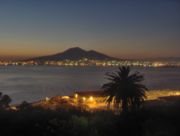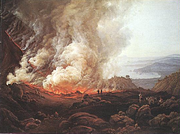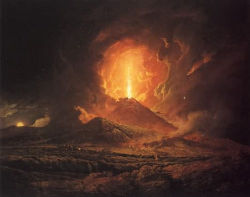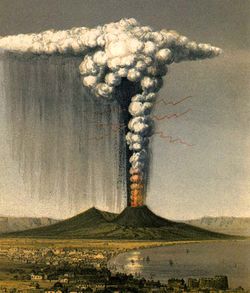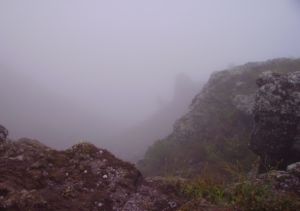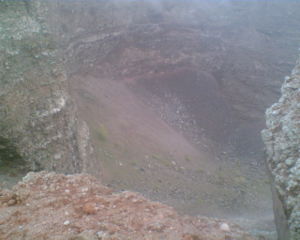Mount Vesuvius
2007 Schools Wikipedia Selection. Related subjects: European Geography
| Mount Vesuvius | |
|---|---|
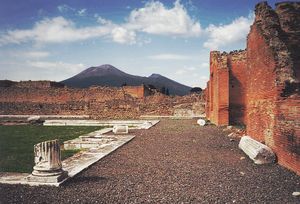 Mt. Vesuvius as seen from Pompeii, which was destroyed in the eruption of 79. The active cone is the high peak on the left side; the smaller one on the right is part of the Somma caldera wall. |
|
| Elevation | 1 281 m as of 1944 |
| Location | Italy |
| Coordinates | |
| Type | Stratovolcano |
| Age of rock | Oldest 25,000 yr |
| Last eruption | 1944 |
| Easiest route | walk |
Mount Vesuvius ( Italian: Monte Vesuvio, Latin: Mons Vesuvius) is a volcano east of Naples, Italy. It is the only volcano on the European mainland to have erupted within the last hundred years, although it is not currently erupting. The only other two such volcanoes in Italy ( Etna and Stromboli) are located on islands.
Vesuvius is on the coast of the Bay of Naples, about nine kilometres (six miles) east of Naples and a short distance from the shore. It is conspicuous in the beautiful landscape presented by the Bay of Naples, when seen from the sea, with Naples in the foreground. Vesuvius is best known for its eruption in A.D. 79 that led to the destruction of the Roman cities of Pompeii and Herculaneum. It has erupted many times since and is today regarded as one of the most dangerous volcanoes in the world because of the population of 3,000,000 people now living close to it and its tendency towards explosive eruptions.
Mount Vesuvius was regarded by the Greeks and Romans as being sacred to the hero and demigod Hercules/Heracles, and the town of Herculaneum, built at its base, was named after him.
Origin of the name
There are three theories about the origin of the name Vesuvius:-
- Hercules was son of the god Zeus and Alcmene of Thebes. Zeus was also known as Ves (Ὓης) in his aspect as the god of rains and dews. Hercules was thus alternatively known as Vesouvios (Ὓσου υἱός), "Son of Ves." This name was corrupted into "Vesuvius".
- From the Oscan word fesf which means "smoke".
- From the Proto-Indo-European root ves- = " hearth"
Physical appearance
Vesuvius is a distinctive "humpbacked" mountain, consisting of a large [cone] (Gran Cono) partially encircled by the steep rim of a summit caldera caused by the collapse of an earlier, and originally much higher structure called Monte Somma. The Gran Cono was produced during the eruption of 79. For this reason, the volcano is also called Somma-Vesuvius or Somma-Vesuvio.
The caldera started forming during an eruption around 17000 (or 18,300) years ago and was enlarged by later paroxysmal eruptions ending in the one of 79. This structure has given its name to the term " somma volcano", which describes any volcano with a summit caldera surrounding a newer cone.
The height of the main cone has been constantly changed by eruptions but presently is 1,281 m (4,202 ft). Monte Somma is 1,149 m (3,770 ft) high, separated from the main cone by the valley of Atrio di Cavallo, which is some 3 miles (5 km) long. The slopes of the mountain are scarred by lava flows but are heavily vegetated, with scrub at higher altitudes and vineyards lower down. Vesuvius is still regarded as an active volcano, although its current activity produces little more than steam from vents at the bottom of the crater. Vesuvius is a stratovolcano at the convergent boundary where the African Plate is being subducted beneath the Eurasian Plate. Its lava is composed of viscous andesite. Layers of lava, scoriae, ashes, and pumice make up the mountain.
Formation
Vesuvius was formed as a result of the collision of two tectonic plates, the African and the Eurasian. The former was pushed beneath the latter, becoming pushed deeper into the Earth. The crust material became heated until it melted, forming magma, one kind of liquid rock. Because magma is less dense than the solid rock around it, it became pushed upward, finding a weak place at the Earth's surface. It broke through, forming the volcano.
Eruptions
Vesuvius has erupted repeatedly in recorded history, most famously in 79 and subsequently in 472, 512, in 1631, six times in the 18th century, eight times in the 19th century (notably in 1872), and in 1906, 1929, and 1944. There has been no eruption since 1944. The eruptions vary greatly in severity but are characterized by explosive outbursts of the kind dubbed Plinian after Pliny the Younger, the Roman naturalist who observed the 79 eruption, and whose uncle Pliny the Elder possibly fell victim to it. On occasion, the eruptions have been so large that the whole of southern Europe has been blanketed by ashes; in 472 and 1631, Vesuvian ashes fell on Constantinople (Istanbul), over 1,200 km away. A few times since 1944, landslides in the crater raised clouds of ash dust, which caused false alarms of an eruption.
Eruption of 79
By the 1st century, Pompeii was only one of a number of towns located around the base of Mount Vesuvius. The area had a substantial population which grew prosperous from the region's renowned agricultural fertility. Many of Pompeii's neighboring communities, most famously Herculaneum, also suffered damage or destruction during the 79 eruption, which is thought to have lasted about 19 hours, in which time the volcano released about 1 cubic mile (4 cubic kilometres) of ash and rock over a wide area to the south and south-east of the crater, with about 3 m (10 ft) of tephra falling on Pompeii.The white pumiceous ash associated with this eruption was mainly of leucite phonolite composition.
Foreshocks
The 79 eruption was preceded by a powerful earthquake seventeen years beforehand on 5 February 62, which caused widespread destruction around the Bay of Naples, and particularly to Pompeii. Some of the damage had still not been repaired when the volcano erupted . However, this may have been a tectonic event rather than one associated with the re-awakening of the volcano.
Another smaller earthquake took place in 64; it was recorded by Suetonius in his biography of Nero, in De Vita Caesarum, and by Tacitus in Book XV of Annales because it took place whilst Nero was in Naples performing for the first time in a public theatre. Suetonius recorded that the emperor continued singing through the earthquake until he had finished his song, whilst Tacitus wrote that the theatre collapsed shortly after being evacuated.
The Romans grew used to minor earth tremors in the region; the writer Pliny the Younger writing that they "were not particularly alarming because they are frequent in Campania". In early August of 79, springs and wells dried up . Small earthquakes started taking place on 20 August, 79, becoming more frequent over the next four days, but the warnings were not recognised (it is worth noting the Romans had no word for volcano, and only a hazy concept of other similar mountains like Mount Etna, home of Vulcan), and on the afternoon of August 24, a catastrophic eruption of the volcano started. The eruption devastated the region, burying Pompeii and other settlements. By coincidence it was the day after Vulcanalia, the festival of the Roman god of fire.
The Two Plinys
Pliny the Younger
The only surviving reliable eyewitness account of the event was recorded by Pliny the Younger in two letters to the historian Tacitus. Observing it from Misenum (approximately 35 km from the volcano) whilst his uncle sailed closer, he saw an extraordinarily dense and rapidly-rising cloud appearing above the mountain:
| I cannot give you a more exact description of its figure, than by resembling it to that of an umbrella pine tree; for it shot up to a great height in the form of a tall trunk, which spread out at the top into a sort of branches. It appeared sometimes bright, and sometimes dark and spotted, as it was either more or less filled with earth and cinders. |
This was the eruption column, now estimated to have been more than 32 km (20 miles) tall.
After some time he described the cloud rushing down the flanks of the mountain and covered everything around it, including the surrounding sea. This is known today as a pyroclastic flow, which is a cloud of superheated gas, ash, and rock that erupts from a volcano. Geologists have used the magnetic characteristics of over 200 volcanic rocks and pieces of debris (eg roof tiles) found in Pompeii to estimate the temperature of this pyroclastic flow. (When molten rock solidifies, magnetic minerals in the rock record the direction of Earth's magnetic field. If the material is heated above a certain temperature, known as the Curie temperature, the magnetic field may be modified or completely reset.) Most of the materials analyzed experienced temperatures between 240 °C and 340 °C (with a few areas showing lower temperatures of only 180 °C). This suggests that the ash cloud had a temperature of 850 °C when emerging from the mouth of Vesuvius and had cooled to below 350 °C by the time it reached the city. It is theorized that turbulence may have mixed cool air into the ash cloud. (Cioni, et al., 2004). This is now called the Plinian stage of the eruption, named after both the younger and elder Plinys.
Pliny stated that several earth tremors were felt at the time of the eruption and were followed by a very violent shaking of the ground. He also noted that ash was falling in very thick sheets and the village he was in had to be evacuated, and then that the sun was blocked out by the eruption and the daylight hours were left in darkness. Also, the sea was sucked away and forced back by an "earthquake", a phenomenon now called a tsunami.
Pliny the Elder
Pliny’s uncle Pliny the Elder was in command of the Roman fleet at Misenum, on the far side of the bay, and had meanwhile decided to take several ships to investigate the phenomenon at close hand. The fleet also took on a rescue mission for those at the foot of the volcano when, as it was preparing to leave, a messenger arrived from a friend of Pliny’s living on the coast near the foot of the volcano imploring him to rescue her. He set off across the bay but encountered thick showers of hot cinders, lumps of pumice and pieces of rock which, altering the shoreline and water depths, blocked his approach to the shore and prevented him from landing there. The prevailing southerly wind also stopped him landing there, but he continued south under it to Stabiae (about 4.5 km from Pompeii) where he landed and took shelter with Pomponianus, a friend. Pomponianus had already loaded a ship with possessions and prepared to leave, but the wind was against him.
Pliny and his party saw flames coming from several parts of the mountain (probably pyroclastic flows and surges, which would later destroy Pompeii and Herculaneum). After staying overnight, the party decided to evacuate in spite of the rain of tephra because of the continuing violent earth threatening to collapse the building. Pliny, Pomponianus and their companions made their way back towards the beach with pillows tied on their heads to protect them from the rockfall. By this time, there was so much ash in the air that the party could barely see through the murk and needed torches and lanterns to find their way. They made it to the beach but found the water too violently disturbed from the continuous earthquakes for them to escape safely by sea.
Pliny the Elder collapsed and died, and in the first letter to Tacitus his nephew suggested that this was due to the inhalation of poisonous, sulphurous gases. However, Stabiae was 16 km from the vent (roughly where the modern town of Castellammare di Stabia is) and his companions were apparently unaffected by the fumes, and so it is more likely that the corpulent Pliny died through a different cause, such as a stroke or heart attack. His body was found with no apparent injuries on 26 August, after the plume had dispersed sufficiently for daylight to return.
Casualties from the eruption
Estimates of the population of Pompeii range from 10,000 to 20,000, whilst Herculaneum is thought to have had a population of about 5,000. It is not known how many people the eruption killed, although around 1,150 remains of bodies have been recovered, or casts made of their impressions in the ash deposits in and around Pompeii. The remains of about 350 bodies have been found at Herculaneum (300 in arched vaults discovered in 1980). However these figures must represent a great underestimate of the total number of deaths over the region affected by the eruption.
38% of the victims at Pompeii were found in the ash fall deposits; the majority inside buildings. These are thought to have been killed mainly by roof collapses, with the smaller number of victims found outside of buildings probably being killed by falling roof slates or by larger rocks thrown out by the volcano. This differs from modern experience, since over the last four hundred years only around 4% of victims have been killed by ash falls during explosive eruptions. The remaining 62% of remains found at Pompeii were in the pyroclastic surge deposits, and thus were probably killed by them – probably from a combination of suffocation through ash inhalation and blast and debris thrown around. In contrast to the victims found at Herculaneum, examination of cloth, frescoes and skeletons show that it is unlikely that high temperatures were a significant cause.
Herculaneum, which was much closer to the crater, was saved from tephra falls by the wind direction, but was buried under 23 m (75 ft) of material deposited by pyroclastic surges. It is likely that most, or all, of the victims in this town were killed by the surges, particularly given evidence of high temperatures found on the skeletons of the victims found in the arched vaults, and the existence of carbonised wood in many of the buildings.
Pompeii and Herculaneum were never rebuilt, although surviving townspeople and probably looters did undertake extensive salvage work after the destructions. The eruption changed the course of the River Sarno and raised the sea beach, so that Pompeii was now neither on the river nor adjacent to the coast.
The towns' locations were eventually forgotten until their accidental rediscovery in the 18th century. Vesuvius itself underwent major changes — its slopes were denuded of vegetation and its summit had changed considerably due to the force of the eruption.
Later eruptions
Since the eruption of 79, Vesuvius has erupted around three dozen times. It erupted again in 203, during the lifetime of the historian Cassius Dio. In 472, it ejected such a volume of ash that ashfalls were reported as far away as Constantinople. The eruptions of 512 were so severe that those inhabiting the slopes of Vesuvius were granted exemption from taxes by Theodoric the Great, the Gothic king of Italy. Further eruptions were recorded in 787, 968, 991, 999, 1007 and 1036 with the first recorded lava flows. The volcano became quiescent at the end of the 13th century and in the following years it again became covered with gardens and vineyards as of old. Even the inside of the crater was filled with shrubbery.
Vesuvius entered a new and particularly destructive phase in December 1631, when a major eruption buried many villages under lava flows, killing around 3,000 people. Torrents of boiling water were also ejected, adding to the devastation. Activity thereafter became almost continuous, with relatively severe eruptions occurring in 1660, 1682, 1694, 1698, 1707, 1737, 1760, 1767, 1779, 1794, 1822, 1834, 1839, 1850, 1855, 1861, 1868, 1872, 1906, 1926, 1929, and 1944. The eruption of 1906 was particularly destructive, killing over 100 people and ejecting the most lava ever recorded from a Vesuvian eruption. Its last major eruption as of 2006 came in March 1944, destroying the villages of San Sebastiano al Vesuvio, Massa di Somma, Ottaviano, and part of San Giorgio a Cremano, as well as all 88 planes in a U.S. B-25 bomber group , as World War II continued to rage in Italy.
The volcano has been quiescent ever since. Over the past few centuries, the quiet stages have varied from 18 months to 7½ years, making the current lull in activity the longest in nearly 500 years. While Vesuvius is not thought likely to erupt in the immediate future, the danger posed by future eruptions is seen as very high in the light of the volcano's tendency towards sudden extremely violent explosions and the very dense human population on and around the mountain.
The future
Large plinian eruptions which emit magma in quantities of about 1 km³ or more, the most recent of which overwhelmed Pompeii, have happened after periods of inactivity of a few thousand years. Sub-plinian eruptions producing about 0.1 km³, such as those of 472 and 1631, have been more frequent with a few hundred years between them. Following the 1631 eruption until 1944 every few years saw a comparatively small eruption which emitted 0.001-0.01 km³ of magma. It seems that for Vesuvius the amount of magma expelled in an eruption increases very roughly linearly with the interval since the previous one, and at a rate of around 0.001 km³ for each year. This gives an extremely approximate figure of 0.06 km³ for an eruption after 60 years of inactivity.
Magma sitting in an underground chamber for many years will start to see higher melting point constituents such as olivine crystallising out. The effect is to increase the concentration of dissolved gases (mostly steam and carbon dioxide) in the remaining liquid magma, making the subsequent eruption more violent. As gas-rich magma approaches the surface during an eruption, the huge drop in pressure caused by the reduction in weight of the overlaying rock (which drops to zero at the surface) causes the gases to come out of solution, the volume of gas increasing explosively from nothing to perhaps many times that of the accompanying magma. Additionally, the removal of the lower melting point material will raise the concentration of felsic components such as silicates potentially making the magma more viscous, adding to the explosive nature of the eruption.
The emergency plan for an eruption therefore assumes that the worst case will be an eruption of similar size and type to the 1631 one (which was VEI 4). In this scenario the slopes of the mountain, extending out to about 7 kilometres (4.3 miles) from the vent, may be exposed to pyroclastic flows sweeping down them, whilst much of the surrounding area could suffer from tephra falls. Because of prevailing winds, towns to the south and east of the volcano are most at risk from this, and it is assumed that tephra accumulation exceeding 100 kg/m² – at which point people are at risk from collapsing roofs – may extend out as far as Avellino to the east or Salerno to the south east. Towards Naples, to the north west, this tephra fall hazard is assumed to barely extend past the slopes of the volcano. The specific areas actually affected by the ash cloud will depend upon the particular circumstances surrounding the eruption .
The plan assumes between 20 days and two weeks notice of an eruption and foresees the emergency evacuation of 600,000 people, almost entirely comprising all those living in the zona rossa ("red zone"), i.e. at greatest risk from pyroclastic flows. The evacuation, by trains, ferries, cars and buses is planned to take about seven days, and the evacuees will mostly be sent to other parts of the country rather than to safe areas in the local Campania region, and may have to stay away for several months. However the dilemma that would face those implementing the plan is when to start this massive evacuation, since if it is left too late then many people could be killed, whilst if it is started too early then the precursors of the eruption may turn out to have been a false alarm. In 1984, 40,000 people were evacuated from the Campi Flegrei area, another volcanic complex near Naples, but no eruption occurred .
Ongoing efforts are being made to reduce the population living in the red zone, by demolishing illegally constructed buildings, establishing a national park around the upper flanks of the volcano to prevent the erection of further buildings and by offering financial incentives to people for moving away. The underlying goal is to reduce the time needed to evacuate the area, over the next 20 or 30 years, to two or three days.
The volcano is closely monitored by the Osservatorio Vesuvio in Naples with extensive networks of seismic and gravimetric stations, a combination of a GPS-based geodic array and satellite-based synthetic aperture radar to measure ground movement, and by local surveys and chemical analyses of gases emitted from fumaroles. All of this is intended to track magma rising underneath the volcano. So far, no magma has been detected within 10 km of the surface, and so the volcano was, in 2001, at worst only in the very early stages of preparing for an eruption. This status has apparently not changed much to date .
Vesuvius today
The area around Vesuvius was officially declared a national park on 5 June 1995. The summit of Vesuvius is open to visitors and there is a small network of paths around the mountain that are maintained by the park authorities on weekends.
There is access by road to within 200 metres of the summit (measured vertically), but thereafter access is on foot only. There is a spiral walkway around the mountain from the road to the crater.
You can also look around parts of Herculaneum and Pompeii which have been uncovered.
![View of the [crater] wall of Vesuvius, with Naples in the background](../../images/92/9282.jpg)
